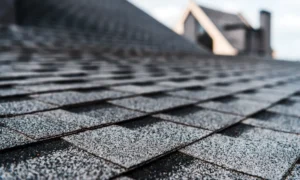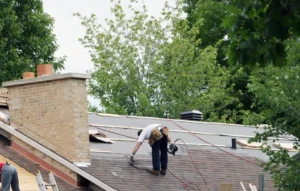
When it comes to roofing, one size does not fit all. Choosing the right roofing material should be heavily influenced by the climate in which you live. The weather conditions in your area can have a significant impact on the longevity and performance of your roof. Our region of Northeast Tennessee and Southwest Virginia is generally mild, however we can experience some intense storms.
Here are some key factors to consider when selecting the right roofing material for your climate.
1. Weather Extremes:
Hot and Dry Climates: If you reside in a hot and arid region, like the southwestern United States, you’ll want a roofing material that can withstand intense heat and sun exposure. Consider materials like clay tiles or metal roofing, which reflect heat and provide good insulation.
Cold and Snowy Climates: In colder regions prone to snow and ice, such as the northern states, a durable and insulating material like asphalt shingles, metal, or slate might be your best bet. These materials can handle the weight of snow and are resistant to frost damage.
2. Rainfall and Humidity:
High Rainfall Areas: In areas with more rainfall and high humidity, such as the Northeast Tennessee, materials like asphalt shingles, cedar shakes, or metal roofing can effectively shed water and resist mold and rot. Best Roofing uses products such as Brava and Davinci RoofScapes .
Coastal Regions: Coastal areas with saltwater exposure demand corrosion-resistant materials like metal roofing or concrete tiles to combat the corrosive effects of salt-laden air.
3. Wind and Storms:
Hurricane-Prone Areas: If you live in hurricane-prone regions like Florida, impact-resistant asphalt shingles, metal roofing, or concrete tiles are wise choices. These materials are less likely to be torn off during high winds.
Tornado-Prone Areas: In tornado-prone states, reinforced materials like metal or composite roofing can offer better protection against flying debris.
Our local area can experience high winds and downbursts, so be sure to ask a Best Roofing expert to help you with choosing the right roofing material!
4. Energy Efficiency:
Hot Climates: Reflective roofing materials like cool roofing membranes or metal can help keep your home cooler by reflecting sunlight. This can reduce your cooling costs in hot climates.
Cold Climates: In colder regions, consider materials with good insulation properties, like metal roofs with added insulation, to prevent heat loss.
5. Maintenance:
Don’t forget to consider the level of maintenance your chosen roofing material requires. Some materials, like wood shakes, may need regular sealing or staining, while others, like metal or asphalt shingles, are relatively low-maintenance.
Climate plays a crucial role in choosing the right roofing material. It’s essential to consult with roofing professionals who are familiar with the local climate and can provide expert guidance. By choosing the right roofing material, you can ensure the longevity and performance of your roof, providing peace of mind and protection for your home in all weather conditions.



